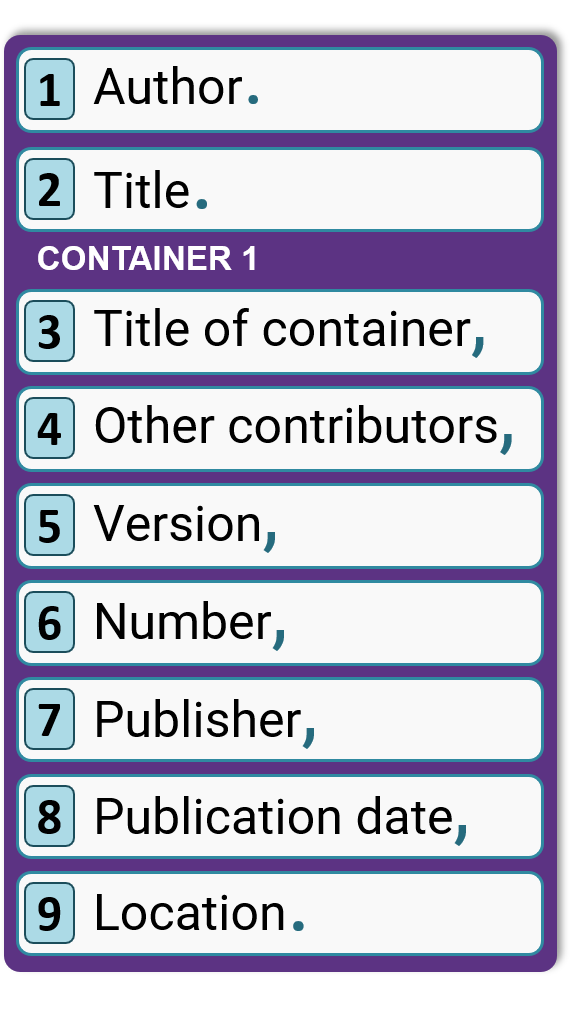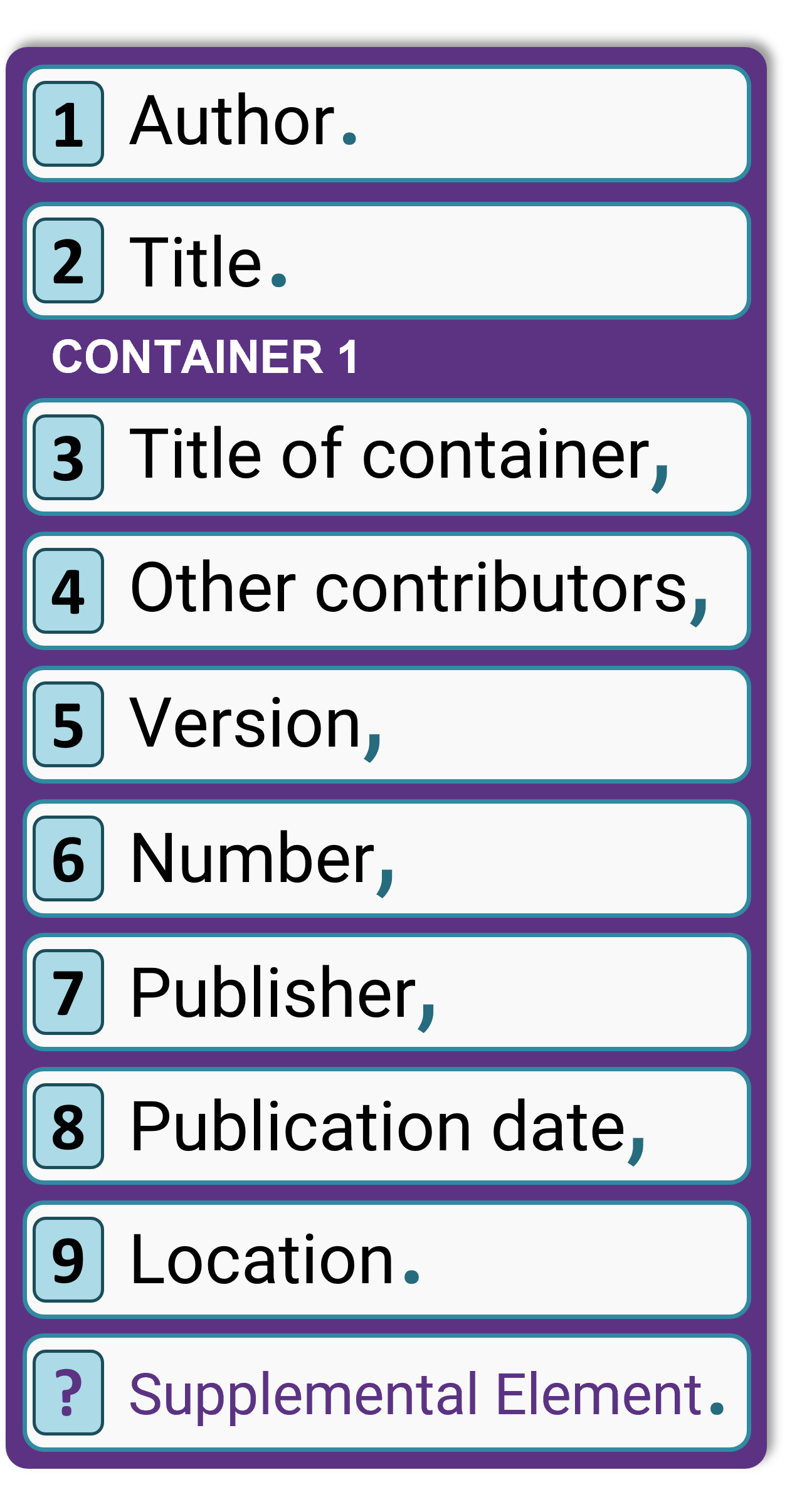Works Cited Entries for Digital Resources
Digital Resources: An Endless Array of Possibilities
Digital resources come in a plethora of different varieties, many of which have already been covered earlier in this chapter. This section will attempt to provide a representative list of other types of digital sources that you might encounter. However, given the nature of our online world, it is impossible to provide an exhaustive list of this type. Do not despair though, the formatting process in MLA always follows the same general process, and each major resource type includes a general flow chart to help you conceptualize how different but related types of digital sources might be formatted.
Page on a Website
Just one container is needed for most websites. You generally do not need to include “http://” or “https://” in the URL address.
-
Hollmichel, Stephanie. “The Reading Brain: Differences between Digital and Print.” So Many Books, 25 Apr. 2013, somanybooksblog.com/2013/04/25/the-reading-brain-differences-between-digital-and-print/.
Elements used in this citation example are author, title, title of container, publication date, and location.
Images & Multimedia
This broad category represents one of the largest and most diverse collections in this reference resource. As with previous sections, notice that the flowchart provided below can be used to anticipate and decode all of the source types noted below. If you encounter a unique variation of any of the sources that follow, this flowchart should allow you to construct the Works Cited entry.

Image — Photograph or Artwork
Most often, images and artwork will only need one container. The main difference in a citation for an online work vs. viewing the work firsthand is the location element. Online will often use a URL (most often without http://), and an in-person viewing will list the physical location where the artwork was viewed. There is a question mark after the date in the first citation as the exact date is unknown.
Image Viewed In Person
-
Theotokopoulos, Domenikos. St. James the Less. 1595?, Hyde Collection, Glens Falls, NY.
Elements used in this citation example are author, title, publication date, and location.
Image Viewed Online
-
Cassatt, Mary. “La Toilette.” 1890. The Met: The Collection, Drawings and Prints, www.metmuseum.org/art/collection/search/337064.
Elements used in this citation example are author, title, date as a supplemental element, title of container, and location.
Online Video (Including YouTube Resources)
Videos accessed via the web will most likely need just one container.
-
“Digoxin Nursing Pharmacology NCLEX (Cardiac Glycosides).” YouTube, uploaded by RegisteredNurseRN, 9 Mar. 2019, www.youtube.com/watch?v=S73GT32EE48.
Elements used in this citation example are title, title of container, contributor, publication date, and location.
Television Program
Television programs may need two containers. In addition to the original airing information, you may need a second container to show how you accessed the program.
NOTE: When the item is part of a whole (an episode within a series for example), the title is contained within quotation marks and not italicized.
Television Viewed Online
-
“Episode 1.” Call the Midwife, season 11, episode 1, BBC, 20 Mar. 2022. WMHT Public Media, 2022, www.pbs.org/video/call-the-midwife-season-11-episode-1/.
-
“In the Graveyard.” New Amsterdam, season 2, episode 13, NBC, 11 Feb. 2020. Hulu, https://www.hulu.com/watch/26be7472-2727-4d02-b77a-22bdeb79278e.
Elements used in the first citation example are title, title of container 1, number, publisher, publication date, title of container 2, date (of 2nd container), and location.Elements used in the second citation example are title, title of container 1, number, publisher, publication date, title of container 2, location, and the date accessed.
Television Viewed In an App
-
“Episode 4.” Downton Abbey, original UK version, season 3, episode 4, BBC, 19 Jan. 2013. Amazon Prime Video app.
-
“Episode 7.” Call the Midwife, season 10, episode 7, BBC, 14 Nov. 2021. Netflix app.
Elements used in the first citation example are title, title of container 1, version, number, publisher, publication date, and final supplemental element.Elements used in the second citation example are title, title of container 1, number, publisher, publication date, and final supplemental element.
Radio Program
Live Radio Broadcast
Elements used in this example are title, title of container, publisher, and publication date.
Radio Listened to Online
-
“Kazuo Ishiguro Draws on His Songwriting Past to Write Novels About the Future.” Fresh Air. NPR, 8 Apr. 2022, www.npr.org/2022/04/08/1091256917/kazuo-ishiguro-draws-on-his-songwriting-past-to-write-novels-about-the-future.
Elements used in this example are title, title of container, publisher, publication date, and location.
Podcast
If the podcast is self-contained, it will need one container. If the podcast is within a larger site, like the last example below, it will use two containers.
-
Brown, Brené. “Brené with Jason Sudeikis and Brendan Hunt on Ted Lasso.” Unlocking Us with Brené Brown, Parcast Network, 7 Oct. 2020. Podcasts app.
-
Fogarty, Mignon. “The Oxford comma. And should you start a sentence with ‘and’?” Grammar Girl Quick and Dirty Tips for Better Writing, episode 866, Quick and Dirty Tips, 10 Mar. 2022. Podcasts app.
-
Rutherford, Adam, and Hanna Fry. “The Colour Conundrum.” The Curious Cases of Rutherford and Fry, series 19, BBC, 24 Mar. 2022. www.bbc.co.uk/sounds/play/m0015lx9.
Elements generally used with a podcast are host, title of the episode, title of the container (program name), the publisher (or network), the publication date, and the location. With the first two examples, the location is added as a supplemental element at the end. In the last example, a second container with the title of the 2nd container and the location are used.
Film or DVD
Films viewed on a DVD or in the theater would need one container. A film viewed online or in an app will need two containers.
Film Viewed Online
Elements used in this citation example are title, contributors, publisher, publication date, title of container 2, and location.
DVD
Elements used in this citation example are title, contributor, publisher, publication date, and final supplemental element.
Album or Song
Album
-
Joel, Billy. Piano Man. Columbia, 1973.
-
Lady Gaga. The Fame Monster. Interscope, 2009.
Elements used in these citation examples are author, title, publisher, and publication date.
Song
Song from an Album
Elements used in these citation examples are author, title, title of container (album), publisher, and publication date.
Song from an Online Streaming Service
If the song was from an app, that is added as a supplemental element after the publication date.
Blog Entry/Comment
Blog Post
Access information for blog posts and comments is presented in a similar manner to how website information is presented.
-
Hollmichel, Stephanie. “The Reading Brain: Differences between Digital and Print.” So Many Books, 25 Apr. 2013, somanybooksblog.com/2013/04/25/the-reading-brain-differences-between-digital-and-print/. Accessed 25 May 2017.
-
Zendell, Anna. “Creating Effective Class Presentations Using the Excelsior OWL Presentation Resources.” Hoot – The Excelsior OWL Blog, 11 Dec. 2019, owl.excelsior.edu/blog/creating-effective-class-presentations-using-the-excelsior-owl-presentation-resources/. Excelsior OWL.
Elements used in the first citation example include author, title, title of container, publication date, location (website address), and the accessed date as a final supplemental item. The link to this page no longer takes you to the article, so the accessed date establishes when this content was viewed.
Elements used in the second citation example include author, title, title of container, publication date, location (website address), and title of container 2.
Blog Comment
To cite a comment on a blog post or article, include the name of the commenter, if available, and “Comment on” before the title of the article and the URL of the comment, not the post.
-
Hughson, Monica. Comment on “Meditations on Uncertain Times.” Well, New York Times, 30 Mar. 2022, nyti.ms/3JVQ0lr#permid=117730711
Elements in this citation example include author of the comment, title, title of container, publisher, publication date, and location.
Online Course Content & Discussion Boards
Formatting entries for online course pages, lectures, and discussion posts should follow similar formatting that you will find for other online sources in the 9th edition of MLA. Provide as much information as you can based on an online resource example. Since the information is accessed directly online, you will likely need just one container system.
If you are citing a lecture and it has a specific title, list that in the place of the generic title below. If you are citing a lecture that you listened to or watched online, include a time stamp of the quotation in the text of your essay in the in-text citation.
Course Page
-
Sands, Crystal. “English 101: English Composition.” Excelsior University, 2016, mycourses.excelsior.edu.
Elements used in this citation example are author, title, publisher, publication date, and location.
Discussion Post
-
Brunell, David. “Re: Armstrong Article.” Reflections on Assignment 1, Excelsior University, 2013, mycourses.excelsior.edu.
Elements used in this citation example are author, title, title of container, publisher, publication date, and location.
Lecture
-
Galvez, Lourdes. Lecture on cybersecurity. Blackboard, Online U, 9 Dec. 2020, blackboard.online.edu. Video recording.
Elements used in this citation example are author, title (description), title of container, publisher, publication date, location, and supplemental element.
Slides
-
“Slides 040416.” Goals of Academic Writing, taught by Sunil Gupta. Canvas. Excelsior U, 4 Apr. 2016, excelsior.instructure.com/courses/28587/files/14661915.
Elements used in this citation example are title (description), supplemental element, title of container, publisher, publication date, and location.
Email
When documenting an email message, you will need just one container. Use a description in place of a title using sentence case with no italics or quotation marks.
-
Garnier, Anaïs. E-mail to Fergus Murphy. 5 Apr. 2022.
-
Williams, Lilly. E-mail to the author. 13 Dec. 2021.
Elements in the following citations include author, description (in title element), and date.
Social Media
When you cite material posted on a social media platform, follow the general MLA format template. First list the author of the post, the account name, then finally the title or a description of the post in place of a title. Then list the title of the social media site, the publisher, unless the name of the site’s publisher is essentially the same as the website title. Then provide the date of publication of the post—if given—or the copyright date of the page. Finally, list the URL.
Facebook
Instagram
If the handle is similar to the account name, and you are going to include a url, you generally do not need to also include a handle for the page.
-
kaur, rupi. “it isn’t blood that makes you my sister,” Instagram, 1 Apr. 2022, www.instagram.com/p/CcJ1CRts6E6/.
TikTok
- Keys, Alicia. “Videos.” TikTok, 2020, www.tiktok.com/@aliciakeys?lang=en.
Twitter
- Egan, Jennifer [@NewYorker]. “Black Box.” Twitter, 2 Jun. 2012, www.twitter.com/NewYorker/status/208936416640647170.
LinkedIn
Common Variations in Social Media Resource
No Publication Date
If you are viewing a social media site on a mobile device, and cannot find the publication or copyright date, include the date you accessed the post at the end of the entry.
- Doctors Without Borders. “Photos.” Facebook, https://www.facebook.com/doctorswithoutborders. Accessed 7 Jul. 2021.
No Unique URL
If a post does not have a unique url, you can provide the account owner’s url instead.
The above content has been drawn from the Excelsior Online Writing Lab (OWL). It is published under a Creative Commons Attribution-4.0 International License.





